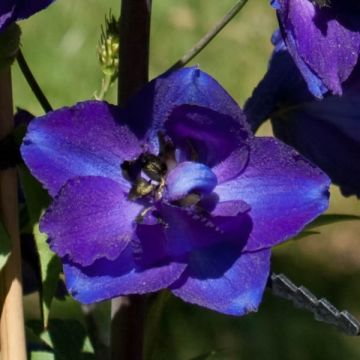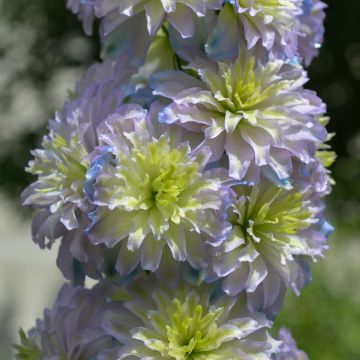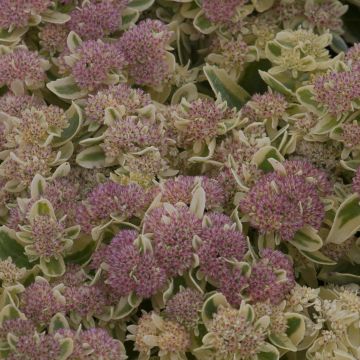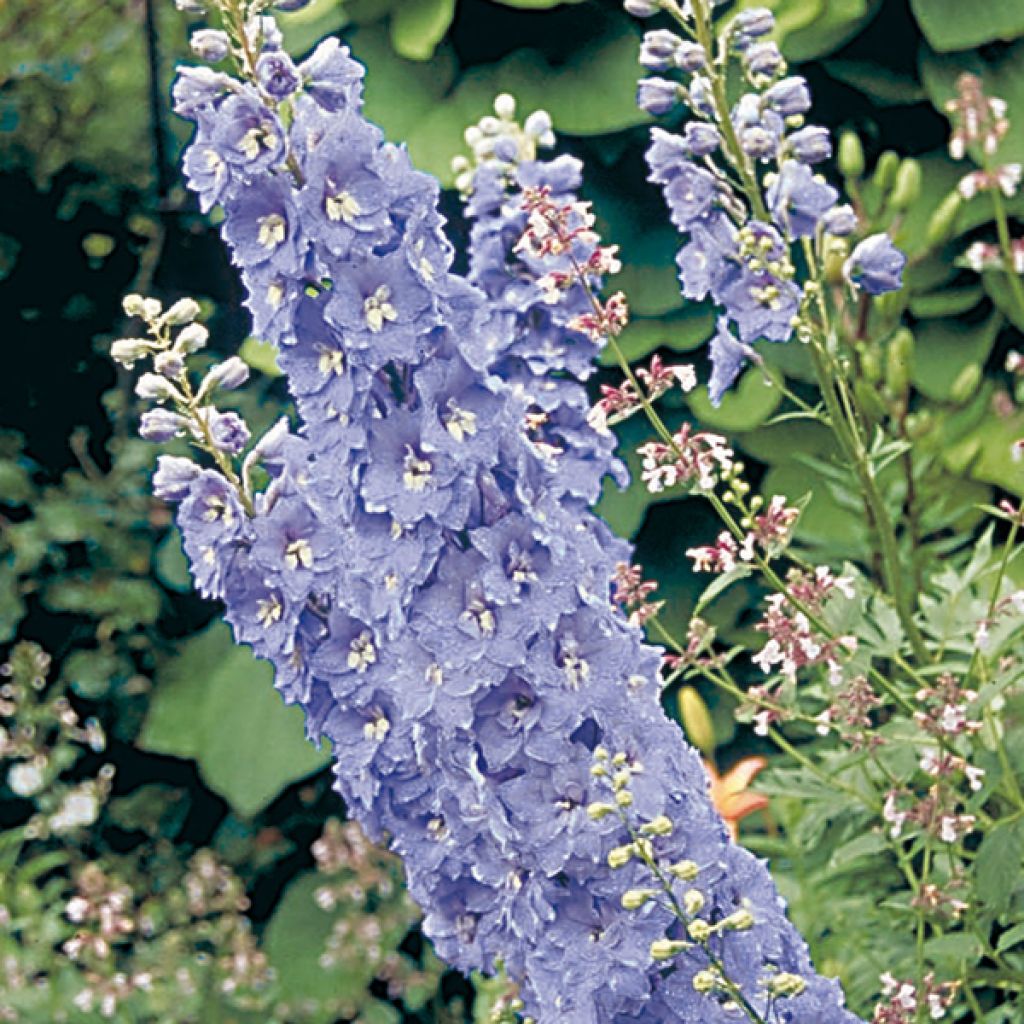

Delphinium Guinevere Group - Larkspur


Delphinium Guinevere Group - Larkspur
Delphinium Guinevere Group - Larkspur
Delphinium Pacific-hybrid Guinevere
Larkspur, Perennial Larkspur
Why not try an alternative variety in stock?
View all →This plant carries a 12 months recovery warranty
More information
We guarantee the quality of our plants for a full growing cycle, and will replace at our expense any plant that fails to recover under normal climatic and planting conditions.
From €5.90 for pickup delivery and €6.90 for home delivery
Express home delivery from €8.90.
From €5.90 for pickup delivery and €6.90 for home delivery
Express home delivery from €8.90.
Does this plant fit my garden?
Set up your Plantfit profile →
Description
Delphinium 'Guinevere Group' is an immense perennial with a very upright habit, and magnificent inflorescences that sometimes reach 1 metre (3 feet) towards the sky. They are adorned with well-distributed semi-double flower spikes, a rare, romantic lilac-pink to purple, illuminated by a small white bee in the heart of each corolla. Flowering is in June, and then again in September if the stems are cut back as they fade.
The 'Guinevere Group' Delphinium is one of the many hybrids obtained by crossing D. elatum, which gave birth, among others, to the famous "Pacific Giant" series. It is a large herbaceous perennial plant with a short lifespan but rapid growth. It forms a clump of palmate, very finely cut, tender green leaves, from which floral spikes 1 m (3ft) to 1.20 m (4ft) tall, carried by numerous stems exceeding 1.80 m (6ft) in height emerge in summer and must be staked. The wide flowers are semi-double, cup-shaped, gathered on tall erect spikes and loved by pollinating insects. They have lavender-pink, pale mauve or faded pink petals, around a tiny white collar, called a 'bee'. The plant develops from a woody rootstock that penetrates vertically into the soil.
The characteristic silhouette of Delphinium always adds breadth, height, and charm to perennial beds. They are good companions for moss or Gallic roses, creating charming and romantic scenes. You can also create a beautiful combination with pink daylilies, mauve or blue paniculate phlox, and baby's breath Rosenschleier. This variety should be carefully staked or supported by tall perennials or flowering bushes. Its flowers hold up well and are particularly appreciated in bouquets.
Note: From March to September, the stems of our delphiniums are pruned short to promote better branching of the crown and achieve optimal rooting. This also prevents the stems from breaking during transportation.
Report an error about the product description
Delphinium Guinevere Group - Larkspur in pictures
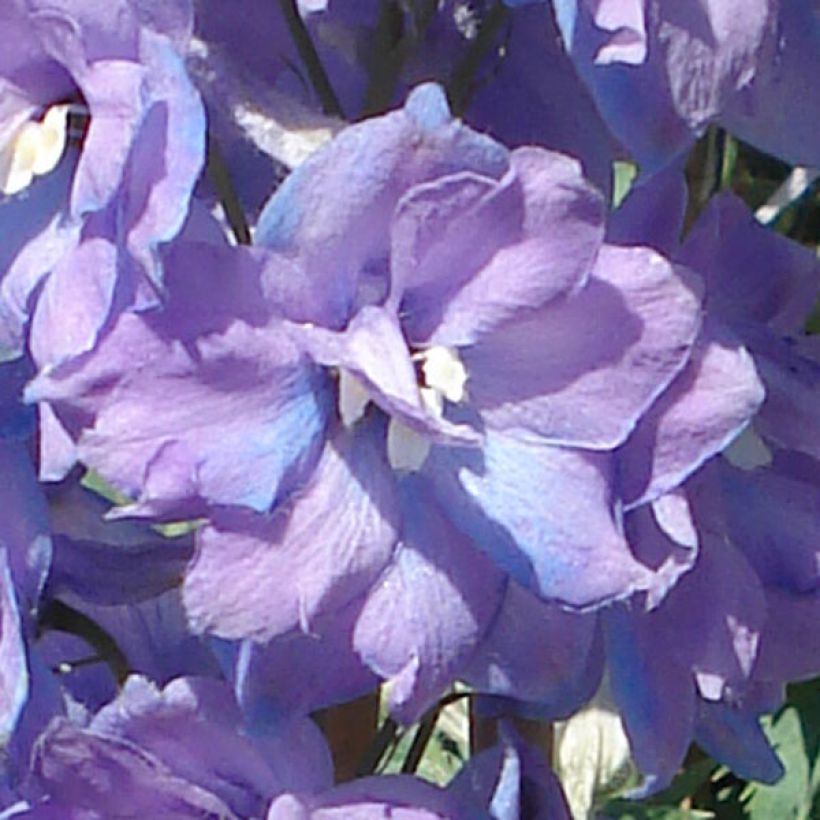



Flowering
Foliage
Plant habit
Safety measures
Botanical data
Delphinium
Pacific-hybrid
Guinevere
Ranunculaceae
Larkspur, Perennial Larkspur
Cultivar or hybrid
ingestion
Cette plante est toxique si elle est ingérée volontairement ou involontairement.
Ne la plantez pas là où de jeunes enfants peuvent évoluer, et lavez-vous les mains après l'avoir manipulée.
Pensez à conserver l'étiquette de la plante, à la photographier ou à noter son nom, afin de faciliter le travail des professionnels de santé.
Davantage d'informations sur https://plantes-risque.info
Other Delphinium - Larkspur
Planting and care
Plant them in spring after the last frosts, in a sunny position, in moist, rich, and well-drained soil. Leave a minimum of two or three shoots on young plants and five to seven on well-established delphiniums. During growth, water once or twice a week and apply liquid fertilizer every two or three weeks. Remove faded flowers by cutting the spikes at the level of the small lateral flowering shoots. Cut back the entire plant to ground level in autumn.
Tip: Dare to go tall with these giant plants that structure and balance the garden. The tallest ones will add volume and lightness against a dark background of hedges or conifers. The intermediate-sized ones will dress up tall flower beds, such as those of giant dahlias. Look after the vegetation with regular watering. Keep an eye out for slugs and snails, especially at the start of the growing season.
Planting period
Intended location
Care
-
, onOrder confirmed
Reply from on Promesse de fleurs
Summer flowering perennials
Haven't found what you were looking for?
Hardiness is the lowest winter temperature a plant can endure without suffering serious damage or even dying. However, hardiness is affected by location (a sheltered area, such as a patio), protection (winter cover) and soil type (hardiness is improved by well-drained soil).

Photo Sharing Terms & Conditions
In order to encourage gardeners to interact and share their experiences, Promesse de fleurs offers various media enabling content to be uploaded onto its Site - in particular via the ‘Photo sharing’ module.
The User agrees to refrain from:
- Posting any content that is illegal, prejudicial, insulting, racist, inciteful to hatred, revisionist, contrary to public decency, that infringes on privacy or on the privacy rights of third parties, in particular the publicity rights of persons and goods, intellectual property rights, or the right to privacy.
- Submitting content on behalf of a third party;
- Impersonate the identity of a third party and/or publish any personal information about a third party;
In general, the User undertakes to refrain from any unethical behaviour.
All Content (in particular text, comments, files, images, photos, videos, creative works, etc.), which may be subject to property or intellectual property rights, image or other private rights, shall remain the property of the User, subject to the limited rights granted by the terms of the licence granted by Promesse de fleurs as stated below. Users are at liberty to publish or not to publish such Content on the Site, notably via the ‘Photo Sharing’ facility, and accept that this Content shall be made public and freely accessible, notably on the Internet.
Users further acknowledge, undertake to have ,and guarantee that they hold all necessary rights and permissions to publish such material on the Site, in particular with regard to the legislation in force pertaining to any privacy, property, intellectual property, image, or contractual rights, or rights of any other nature. By publishing such Content on the Site, Users acknowledge accepting full liability as publishers of the Content within the meaning of the law, and grant Promesse de fleurs, free of charge, an inclusive, worldwide licence for the said Content for the entire duration of its publication, including all reproduction, representation, up/downloading, displaying, performing, transmission, and storage rights.
Users also grant permission for their name to be linked to the Content and accept that this link may not always be made available.
By engaging in posting material, Users consent to their Content becoming automatically accessible on the Internet, in particular on other sites and/or blogs and/or web pages of the Promesse de fleurs site, including in particular social pages and the Promesse de fleurs catalogue.
Users may secure the removal of entrusted content free of charge by issuing a simple request via our contact form.
The flowering period indicated on our website applies to countries and regions located in USDA zone 8 (France, the United Kingdom, Ireland, the Netherlands, etc.)
It will vary according to where you live:
- In zones 9 to 10 (Italy, Spain, Greece, etc.), flowering will occur about 2 to 4 weeks earlier.
- In zones 6 to 7 (Germany, Poland, Slovenia, and lower mountainous regions), flowering will be delayed by 2 to 3 weeks.
- In zone 5 (Central Europe, Scandinavia), blooming will be delayed by 3 to 5 weeks.
In temperate climates, pruning of spring-flowering shrubs (forsythia, spireas, etc.) should be done just after flowering.
Pruning of summer-flowering shrubs (Indian Lilac, Perovskia, etc.) can be done in winter or spring.
In cold regions as well as with frost-sensitive plants, avoid pruning too early when severe frosts may still occur.
The planting period indicated on our website applies to countries and regions located in USDA zone 8 (France, United Kingdom, Ireland, Netherlands).
It will vary according to where you live:
- In Mediterranean zones (Marseille, Madrid, Milan, etc.), autumn and winter are the best planting periods.
- In continental zones (Strasbourg, Munich, Vienna, etc.), delay planting by 2 to 3 weeks in spring and bring it forward by 2 to 4 weeks in autumn.
- In mountainous regions (the Alps, Pyrenees, Carpathians, etc.), it is best to plant in late spring (May-June) or late summer (August-September).
The harvesting period indicated on our website applies to countries and regions in USDA zone 8 (France, England, Ireland, the Netherlands).
In colder areas (Scandinavia, Poland, Austria...) fruit and vegetable harvests are likely to be delayed by 3-4 weeks.
In warmer areas (Italy, Spain, Greece, etc.), harvesting will probably take place earlier, depending on weather conditions.
The sowing periods indicated on our website apply to countries and regions within USDA Zone 8 (France, UK, Ireland, Netherlands).
In colder areas (Scandinavia, Poland, Austria...), delay any outdoor sowing by 3-4 weeks, or sow under glass.
In warmer climes (Italy, Spain, Greece, etc.), bring outdoor sowing forward by a few weeks.





































